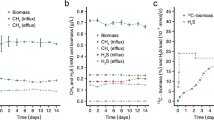Summary
The apparent Ks values for H2 of several phylogenetically distant strains of both methanogenic bacteria and sulfate-reducing bacteria were measured. The sulfate reducers had Ks values of about 2 μM whereas the Ks values of the methanogens were 6–20 μM. This indicates that probably all sulfate-reducing bacteria have a higher substrate affinity for H2 than the methanogenic bacteria. Difference in substrate affinity can thus account for the inhibition of methanogenesis from H2 and CO2 in sulfate-rich ecosystems (mainly saltwater marshes), where the H2 concentration is well below 5 μM. Possible explanations for this general phenomenon are discussed.
Similar content being viewed by others
References
Abram JW, Nedwell DB (1978) Inhibition of methanogenesis by sulphate reducing bacteria competing for transferred hydrogen. Arch Microbiol 117:89–92
Badziong W, Thauer RK (1978) Growth yields and growth rates of Desulfovibrio vulgaris (Marburg) growing on hydrogen plus sulfate and hydrogen plus thiosulfate as the sole energy sources. Arch Microbiol 117:209–214
Badziong W, Thauer RK (1980) Vectorial electron transport in Desulfovibrio vulgaris (Marburg) growing on hydrogen plus sulfate as sole energy source. Arch Microbiol 125:167–174
Balch WE, Fox GE, Magrum LJ, Woese CR, Wolfe RS (1979) Methanogens: Reevaluation of a unique biological group. Microbiol Rev 43:260–296
Banat IM, Nedwell DB, Balba MT (1983) Stimulation of methanogenesis by slurries of saltmarsh sediment after the addition of molybdate to inhibit sulphate-reducing bacteria. J Gen Microbiol 129:123–129
Bell GR, LeGall J, Peck HD Jr (1974) Evidence for the periplasmic location of hydrogenase in Desulfovibrio gigas. J Bacteriol 120:994–997
Brandis A, Thauer RK (1981) Growth of Desulfovibrio species on hydrogen and sulphate as sole energy source. J Gen Microbiol 126:249–252
Bryant MP, Campbell LL, Reddy CA, Crabill MR (1977) Growth of Desulfovibrio in lactate or ethanol media low in sulfate in association with H2-utilizing methanogenic bacteria. Appl Environ Microbiol 33:1162–1169
Fenchel T, Blackburn TH (1979) Bacteria and mineral cycling. Academic press, London New York San Francisco
Fersht A (1977) Enzyme structure and mechanism. Freeman and Co, Reading, San Francisco
Graf EG, Thauer RK (1981) Hydrogenase from Methanobacterium thermoautotrophicum, a nickel-containing enzyme. FEBS Lett 136:165–169
Jørgensen BB (1980) Mineralization and the bacterial cycling of carbon, nitrogen and sulfur in marine sediments. In: Ellwood DC, Hedger JN, Latham MJ, Lynch JM, Slater JH (eds) Contemporary microbial ecology. Academic Press, London New York Toronto Sydney San Francisco, pp 239–251
Jørgensen BB (1982) Mineralization of organic matter in the sea bed — the role of sulphate reduction. Nature 296:643–645
Koch AL, Wang CH (1982) How close to the theoretical diffusion limit do bacterial uptake systems function? Arch Microbiol 131:36–42
Kristjansson JK, Schönheit P, Thauer RK (1982) Different Ks values for hydrogen of methanogenic bacteria and sulfate reducing bacteria: An explanation for the apparent inhibition of methanogenesis by sulfate. Arch Microbiol 131:278–282
Liu MC, Peck HD Jr (1981) The isolation of a hexaheme cytochrome from Desulfovibrio desulfuricans and its identification as a new type of nitrite reductase. J Biol Chem 256:13159–13164
Lovley DR, Dwyer DF, Klug MJ (1982) Kinetic analysis of competition between sulfate reducers and methanogens for hydrogen in sediments. Appl Environ Microbiol 43:1373–1379
Lovley DR, Klug MJ (1983) Sulfate reducers can outcompete methanogens at freshwater sulfate concentrations. Appl Environ Microbiol 45:187–192
Martens CS, Berner RA (1974) Methane production in the interstitial waters of sulfate-depleted marine sediments. Science 185:1167–1169
Matin A, Veldkamp H (1978) Physiological basis of the selective advantage of a Spirillum sp. in a carbon-limited environment. J Gen Microbiol 105:187–197
Mountfort DO, Asher RA, Mays EL, Tiedje JM (1980) Carbon and electron flow in mud and sandflat intertidal sediments at Delaware inlet, Nelson, New Zealand. Appl Environ Microbiol 39:686–694
Oremland RS, Taylor BF (1978) Sulfate reduction and methanogenesis in marine sediments. Geochim Cosmochim Acta 42:209–214
Oremland RS, Polcin S (1982) Methanogenesis and sulfate reduction: Competitive and noncompetitive substrates in estuarine sediments. Appl Environ Microbiol 44:1270–1276
Robinson JA, Tiedje JM (1982a) Resource competition among methanogens and sulfate-reducing bacteria for hydrogen. ASM Abstracts I 95
Robinson JA, Tiedje JM (1982b) Kinetics of hydrogen consumption by rumen fluid, anaerobic digester sludge, and sediment. Appl Environ Microbiol 44:1374–1384
Schauer NL, Brown DP, Ferry JG (1982) Kinetics of formate metabolism in Methanobacterium formicium and Methanospirillum hungatei. Appl Environ Microbiol 44:549–554
Schönheit P, Moll J, Thauer RK (1980) Growth parameters (Ks, μmax, Ys) of Methanobacterium thermoautotrophicum. Arch Microbiol 127:59–65
Schönheit P, Kristjansson JK, Thauer RK (1982) Kinetic mechanism for the ability of sulfate reducers to out-compete methanogens for acetate. Arch Microbiol 132:285–288
van der Westen HM, Mayhew SG, Veeger C (1978) Separation of hydrogenase from intact cells of Desulfovibrio vulgaris. Purification and properties. FEBS Lett 86:122–126
Veldkamp H, Jannasch JW (1972) Mixed culture studies with the chemostat. J Appl Chem Biotechnol 22:105–123
Winfrey MR, Zeikus JG (1977) Effect of sulfate on carbon and electron flow during microbial methanogenesis in freshwater sediments. Appl Environ Microbiol 33:275–281
Winfrey MR, Ward DM (1983) Substrates for sulfate reduction and methane production in interdidal sediments. Appl Environ Microbiol 45:193–199
Author information
Authors and Affiliations
Rights and permissions
About this article
Cite this article
Kristjansson, J.K., Schönheit, P. Why do sulfate-reducing bacteria outcompete methanogenic bacteria for substrates?. Oecologia 60, 264–266 (1983). https://doi.org/10.1007/BF00379530
Received:
Issue Date:
DOI: https://doi.org/10.1007/BF00379530




